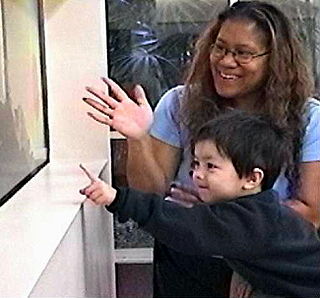Developmental disorders comprise a group of psychiatric conditions originating in childhood that involve serious impairment in different areas. There are several ways of using this term. The most narrow concept is used in the category "Specific Disorders of Psychological Development" in the ICD-10. These disorders comprise developmental language disorder, learning disorders, motor disorders, and autism spectrum disorders. In broader definitions ADHD is included, and the term used is neurodevelopmental disorders. Yet others include antisocial behavior and schizophrenia that begins in childhood and continues through life. However, these two latter conditions are not as stable as the other developmental disorders, and there is not the same evidence of a shared genetic liability.

A social skill is any competence facilitating interaction and communication with others where social rules and relations are created, communicated, and changed in verbal and nonverbal ways. The process of learning these skills is called socialization. Lack of such skills can cause social awkwardness.
Dysgraphia is a learning disability of written expression, which affects the ability to write, primarily handwriting, but also coherence. It is a specific learning disability (SLD) as well as a transcription disability, meaning that it is a writing disorder associated with impaired handwriting, orthographic coding and finger sequencing. It often overlaps with other learning disabilities and neurodevelopmental disorders such as speech impairment, attention deficit hyperactivity disorder (ADHD) or developmental coordination disorder (DCD).

Ole Ivar Løvaas was a Norwegian-American clinical psychologist and professor at the University of California, Los Angeles. He is most well known for his research on what is now called applied behavior analysis (ABA) to teach autistic children through prompts, modeling, and positive reinforcement. The therapy is also noted for its use of aversives (punishment) to reduce undesired behavior, however these are now used less commonly than in the past.

Applied behavior analysis (ABA), also called behavioral engineering, is a psychological intervention that applies empirical approaches based upon the principles of respondent and operant conditioning to change behavior of social significance. It is the applied form of behavior analysis; the other two forms are radical behaviorism and the experimental analysis of behavior.
Nonverbal learning disability (NVLD) is proposed neurodevelopmental disorder characterized by core deficits in visual-spatial processing and a significant discrepancy between verbal and nonverbal intelligence. A review of papers found that proposed diagnostic criteria were inconsistent. Proposed additional diagnostic criteria include intact verbal intelligence, and deficits in the following: visuoconstruction abilities, speech prosody, fine-motor coordination, mathematical reasoning, visuospatial memory and social skills. NVLD is not recognised by the DSM-5 and is not clinically distinct from learning disorder.
The following outline is provided as an overview of and topical guide to autism:
Oppositional defiant disorder (ODD) is listed in the DSM-5 under Disruptive, impulse-control, and conduct disorders and defined as "a pattern of angry/irritable mood, argumentative/defiant behavior, or vindictiveness". This behavior is usually targeted toward peers, parents, teachers, and other authority figures. Unlike conduct disorder (CD), those with ODD do not show patterns of aggression towards people or animals, destruction of property, theft, or deceit. One half of children with ODD also fulfill the diagnostic criteria for ADHD.

Autism therapies include a wide variety of therapies that help people with autism, or their families. Such methods of therapy also seek the increase of functional independence in autistic people. Many therapies marketed towards autistic people and/or their parents claim outcomes that have not been supported by Level of Research (LOE) Level 1. Level 1 research includes evidence from a systematic review or meta-analysis of all relevant RCTs or evidence-based clinical practice guidelines based on systematic reviews of RCTs or three or more RCTs of good quality that have similar results.
In the U.S. the Individuals with Disabilities Education Act (IDEA) is a special education law that mandates regulation for students with disabilities to protect their rights as students and the rights of their parents. The IDEA requires that all students receive a Free and Appropriate Public Education (FAPE), and that these students should be educated in the least restrictive environment (LRE). To determine what an appropriate setting is for a student, an Individualized Education Plan (IEP) team will review the student's strengths, weaknesses, and needs, and consider the educational benefits from placement in any particular educational setting. By law the team is required to include the student's parent or guardian, a general education teacher, a special education teacher, a representative of the local education agency, someone to interpret evaluation results and, if appropriate, the student. It is the IEP team's responsibility to determine what environment is the LRE for any given student with disabilities, which varies between every student. The goal of an IEP is to create the LRE for that student to learn in. For some students, mainstream inclusion in a standard classroom may be an appropriate setting whereas other students may need to be in a special education classroom full time, but many students fall somewhere within this spectrum. Students may also require supplementary aids and services to achieve educational goals while being placed in a classroom with students without disabilities, these resources are provided as needed. The LRE for a student is less of a physical location, and more of a concept to ensure that the student is receiving the services that they need to be successful.
Social Stories were devised as a tool to help individuals with ASD better understand the nuances of interpersonal communication so that they could "interact in an effective and appropriate manner". Although the prescribed format was meant for high functioning people with basic communication skills, the format was adapted substantially to suit individuals with poor communication skills and low level functioning. The evidence shows that there has been minimal improvement in social interaction skills. However, it is difficult to assess whether the concept would have been successful if it had been carried out as designed.
Emotional and behavioral disorders refer to a disability classification used in educational settings that allows educational institutions to provide special education and related services to students who have displayed poor social and/or academic progress.
Parent management training (PMT), also known as behavioral parent training (BPT) or simply parent training, is a family of treatment programs that aims to change parenting behaviors, teaching parents positive reinforcement methods for improving pre-school and school-age children's behavior problems.

Video modeling (VM) is a mode of teaching that uses video recording and display equipment to provide a visual model of the targeted behaviors or skill. In video self-modeling (VSM), individuals observe themselves performing a behavior successfully on video, and then imitate the targeted behavior. Video modeling has been used to teach many skills, including social skills, communication, and athletic performance; it has shown promise as an intervention for children with autism spectrum disorders (ASD). Important practical and theoretical questions remain largely unanswered about video modeling and other forms of video-based intervention. Video modeling has theoretical roots in the social learning theory work of Bandura (1969), which called attention to the ability to learn through observation.
In psychology and neuroscience, executive dysfunction, or executive function deficit, is a disruption to the efficacy of the executive functions, which is a group of cognitive processes that regulate, control, and manage other cognitive processes. Executive dysfunction can refer to both neurocognitive deficits and behavioural symptoms. It is implicated in numerous psychopathologies and mental disorders, as well as short-term and long-term changes in non-clinical executive control.

Autism, formally called autism spectrum disorder (ASD) and autism spectrum condition (ASC), is a neurodevelopmental disorder characterized by deficits in social communication and social interaction, and repetitive or restricted patterns of behaviors, interests, or activities, which can include hyper- and hyporeactivity to sensory input. Autism is a spectrum disorder, meaning that it can manifest very differently in each person. For example, some are nonspeaking, while others have proficient spoken language. Because of this, there is wide variation in the support needs of people across the autism spectrum.
Classwide Peer Tutoring (CWPT) is a variation of peer-mediated instruction that has been used in elementary, middle school, and high school classrooms. In CWPT students form pairs and take turns in the roles of tutor and student. Students earn points for their teams by participating in the tutoring and the winning team is recognized. Researchers have investigated CWPT's effectiveness in several different academic areas.
Social (pragmatic) communication disorder (SPCD), also known as pragmatic language impairment (PLI), is a neurodevelopmental disorder characterized by significant difficulties in the social use of verbal and nonverbal communication. Individuals with SPCD struggle to effectively engage in social interactions, interpret social cues, and use language appropriately in social contexts. This disorder can have a profound impact on an individual's ability to establish and maintain relationships, navigate social situations, and participate in academic and professional settings. Although SPCD shares similarities with other communication disorders, such as autism spectrum disorder (ASD), it is recognized as a distinct diagnostic category with its own set of diagnostic criteria and features.

A social narrative is an evidence-based learning tool designed for use with people with autism spectrum disorder (ASD) and other associated disabilities. Social narratives often use personalized stories to teach a skill, identify a situation, or tell a narrative; some examples of social narratives may cover topics such as getting along with others, interacting with others, or experiencing a new place or activity. It is referred to as a story or a written explanation that tells the learner not only what to do but also what the situation is, with the goal of addressing the challenge of learners finding social situations confusing. Social narratives have been found effective for learners ages Preschool-High School in several areas such as social, communication, joint attention, behavior, adaptive, play, and academic.
Beth Sulzer-Azaroff was a psychologist and pioneering figure in the field of behavior analysis. She conducted research on organizational behavior management and promoted the use of applied behavior analysis for teaching children with autism. The Federation of Associations in Behavioral & Brain Sciences noted her contributions as "instrumental in translating findings from the basic behavior analytic laboratory to the applied setting, from the classroom to the factory."






